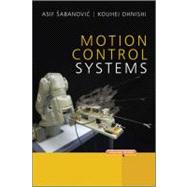
What is included with this book?
Kouhei Ohnishi a Professor of Systems Design Engineering at Keio University. His research interests include power electronics, mechatronics, motion control and haptics. Ohnishi received Best Paper Awards from the Institute of Electrical Engineers of Japan and the Japan Society for Precision Engineering. He also received Dr.-Ing. Eugene Mittelmann Achievement Award from the IEEE Industrial Electronics Society in 2004. Ohnishi holds a BE, ME, and PhD in Electrical Engineering from the University of Tokyo.
About the Authors xi
PART ONE – BASICS OF DYNAMICS AND CONTROL.
1 Dynamics of Electromechanical Systems 3
1.1 Basic Quantities 3
1.1.1 Elements and Basic Quantities in Mechanical Systems 3
1.1.2 Elements and Basic Quantities in Electric Systems 5
1.2 Fundamental Concepts of Mechanical Systems 7
1.2.1 The Principle of Least Action 7
1.2.2 Dynamics 8
1.2.3 Nonpotential and Dissipative Forces 9
1.2.4 Equations of Motion 10
1.2.5 Properties of Equations of Motion 14
1.2.6 Operational Space Dynamics 18
1.3 Electric and Electromechanical Systems 20
1.3.1 Electrical Systems 20
1.3.2 Electromechanical Systems 21
1.3.3 Electrical Machines 24
2 Control System Design 29
2.1 Basic Concepts 30
2.1.1 Basic Forms in Control Systems 31
2.1.2 Basic Relations 35
2.1.3 Stability 36
2.1.4 Sensitivity Function 37
2.1.5 External Inputs 38
2.2 State Space Representation 39
2.2.1 State Feedback 40
2.2.2 Stability 44
2.2.3 Observers 45
2.2.4 Systems with Observers 48
2.2.5 Disturbance Estimation 49
2.3 Dynamic Systems with Finite Time Convergence 51
2.3.1 Equivalent Control and Equations of Motion 52
2.3.2 Existence and Stability 53
2.3.3 Design 53
2.3.4 Control in Linear Systems 55
2.3.5 Sliding Mode Based Observers 56
PART TWO – ISSUES IN MOTION CONTROL.3 Acceleration Control 63
3.1 Plant 63
3.2 Acceleration Control 67
3.2.1 Formulation of Control Tasks 68
3.2.2 Equivalent Acceleration and Equivalent Force 74
3.3 Enforcing Convergence and Stability 85
3.3.1 Convergence for Bounded Control Input 90
3.3.2 Systems with Finite-Time Convergence 94
3.3.3 Equations of Motion 97
3.3.4 General Structure of Acceleration Control 105
3.4 Trajectory Tracking 107
4 Disturbance Observers 115
4.1 Disturbance Model Based Observers 118
4.1.1 Velocity Based Disturbance Observer 119
4.1.2 Position Based Disturbance Observer 121
4.2 Closed Loop Disturbance Observers 127
4.2.1 Internal and External Forces Observers 128
4.3 Observer for Plant with Actuator 132
4.3.1 Plant with Neglected Dynamics of Current Control Loop 133
4.3.2 Plant with Dynamics in Current Control Loop 136
4.4 Estimation of Equivalent Force and Equivalent Acceleration 140
4.5 Functional Observers 144
4.6 Dynamics of Plant with Disturbance Observer 149
4.6.1 Disturbance Estimation Error 150
4.6.2 Dynamics of Plant With Disturbance Observer 151
4.7 Properties of Measurement Noise Rejection 160
4.8 Control of Compensated Plant 164
4.8.1 Application of Estimated ^teq and ^€q
5 Interactions and Constraints 175
5.1 Interaction Force Control 176
5.1.1 Proportional Controller and Velocity Feedback 178
5.1.2 Environment with Losses 182
5.1.3 Lossless Environment 187
5.1.4 Control of Push Pull Force 191
5.2 Constrained Motion Control 193
5.2.1 Modification of Reference 195
5.2.2 Modification by Acting on Equivalent Acceleration 201
5.2.3 Motion Modification while Keeping Desired Force Profile 205
5.2.4 Impedance Control 209
5.2.5 Force Driven Systems 210
5.2.6 Position and Force Control in Acceleration Dimension 211
5.3 Interactions in Functionally Related Systems 215
5.3.1 Grasp Force Control 215
5.3.2 Functionally Related Systems 225
6 Bilateral Control Systems 233
6.1 Bilateral Control without Scaling 234
6.1.1 Bilateral Control Design 238
6.1.2 Control in Systems with Scaling in Position and Force 247
6.2 Bilateral Control Systems in Acceleration Dimension 251
6.3 Bilateral Systems with Communication Delay 256
6.3.1 Delay in Measurement Channel 257
6.3.2 Delay in Measurement and Control Channels 263
6.3.3 Closed Loop Behavior of System with Observer 267
6.3.4 Bilateral Control in Systems with Communication Delay 270
PART THREE – MULTIBODY SYSTEMS.
7 Configuration Space Control 279
7.1 Independent Joint Control 280
7.2 Vector Control in Configuration Space 281
7.2.1 Selection of Desired Acceleration 282
7.3 Constraints in Configuration Space 290
7.3.1 Enforcement of Constraints by Part of Configuration Variables 303
7.4 Hard Constraints in Configuration Space 304
8 Operational Space Dynamics and Control 313
8.1 Operational Space Dynamics 314
8.1.1 Dynamics of Nonredundant Tasks 314
8.1.2 Dynamics of Redundant Tasks 315
8.2 Operational Space Control 318
8.2.1 Nonredundant Task Control 319
8.2.2 Redundant Task Control 328
9 Interactions in Operational Space 337
9.1 Task–Constraint Relationship 337
9.2 Force Control 341
9.3 Impedance Control 345
9.4 Hierarchy of Tasks 347
9.4.1 Constraints in Operational Space 347
9.4.2 Enforcing the Hierarchy of Tasks 352
9.4.3 Selection of Configuration Space Desired Acceleration 357
References 358
Further Reading 358
Index 361
The New copy of this book will include any supplemental materials advertised. Please check the title of the book to determine if it should include any access cards, study guides, lab manuals, CDs, etc.
The Used, Rental and eBook copies of this book are not guaranteed to include any supplemental materials. Typically, only the book itself is included. This is true even if the title states it includes any access cards, study guides, lab manuals, CDs, etc.